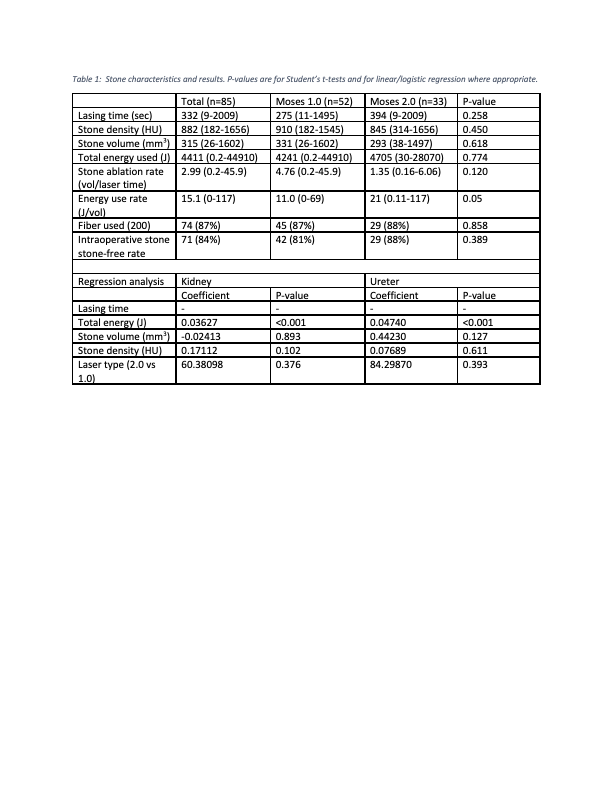Back
Poster, Podium & Video Sessions
Podium
PD55: Stone Disease: Surgical Therapy (including ESWL) IV
PD55-10: Moses 2.0 Laser Impact on Intraoperative Parameters
Monday, May 16, 2022
11:00 AM – 11:10 AM
Location: Room 252
Samuel Antoine, Aurora, CO, Kerri Thurmon, Denver, CO, Michael Atwell, Xavier Glover*, Miguel Rodriguez-Homs, Fernando Kim, Aurora, CO, Rodrigo Donalisio da Silva, Denver, CO
- XG
Podium Presenter(s)
Introduction: The Moses 2.0 laser was introduced to our hospital this year. The pulse-delivery technology increases energy transmission at each working distance. Frequency can be performed as high as 120 Hz which could improve stone dusting times, and energy levels can be performed up to 6 J which could improve fragmentation time. We aimed to evaluate the impact of this technology on patients undergoing ureteroscopy with laser lithotripsy in our hospital cohort.
Methods: We retrospectively analyzed ureteroscopy with laser lithotripsy cases performed at our hospital in 2021. All procedures performed prior to July 1, 2021 were performed with the Moses 1.0 laser, while all subsequent procedures were performed with the Moses 2.0 laser. Variables that were studied included stone density (Hounsfield units, i.e. HU), stone volume (mm3), lasing time, total energy used, stone ablation rate (volume/laser time), energy use rate (J/mm3), intraoperative stone stone-free rate, and complications. Comparisons were made between the Moses 1.0 and 2.0 groups using Student’s t tests. Multiple linear and logistic regression was also performed to evaluate the impact of energy, stone volume, stone density, and laser type on lasing time. A significance level of p-value = 0.05 was used.
Results: There were 82 procedures in this cohort. Statistical results are summarized in table 1. Overall, the only variable that reached statistical significance with Student’s t tests was the energy use rate with a p-value of 0.05. On regression analysis, the type of laser used did not have a statistically significant impact on lasing time when controlling for the total energy used, stone volume, and stone density, though the coefficient for total energy used was statistically significant with a p < 0.001.
Conclusions: The Moses 2.0 laser did deliver more energy per unit stone volume. However, this did not have an impact on lasing time. This remained true when controlling for total energy, stone volume, and density. It is possible that differences in lasing time will become apparent with a larger sample size and more familiarity with the 2.0 laser.
Source of Funding: None

Methods: We retrospectively analyzed ureteroscopy with laser lithotripsy cases performed at our hospital in 2021. All procedures performed prior to July 1, 2021 were performed with the Moses 1.0 laser, while all subsequent procedures were performed with the Moses 2.0 laser. Variables that were studied included stone density (Hounsfield units, i.e. HU), stone volume (mm3), lasing time, total energy used, stone ablation rate (volume/laser time), energy use rate (J/mm3), intraoperative stone stone-free rate, and complications. Comparisons were made between the Moses 1.0 and 2.0 groups using Student’s t tests. Multiple linear and logistic regression was also performed to evaluate the impact of energy, stone volume, stone density, and laser type on lasing time. A significance level of p-value = 0.05 was used.
Results: There were 82 procedures in this cohort. Statistical results are summarized in table 1. Overall, the only variable that reached statistical significance with Student’s t tests was the energy use rate with a p-value of 0.05. On regression analysis, the type of laser used did not have a statistically significant impact on lasing time when controlling for the total energy used, stone volume, and stone density, though the coefficient for total energy used was statistically significant with a p < 0.001.
Conclusions: The Moses 2.0 laser did deliver more energy per unit stone volume. However, this did not have an impact on lasing time. This remained true when controlling for total energy, stone volume, and density. It is possible that differences in lasing time will become apparent with a larger sample size and more familiarity with the 2.0 laser.
Source of Funding: None


.jpg)
.jpg)